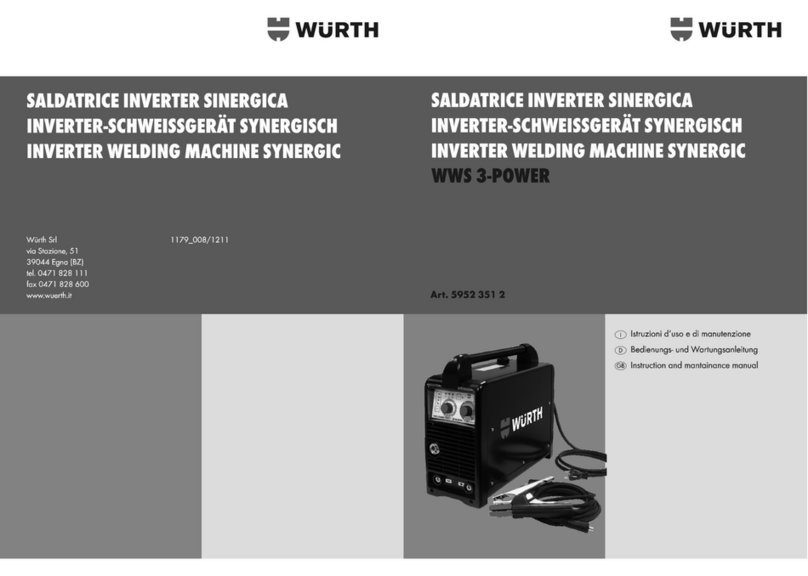
5
Hinweis
Es ist verboten, Veränderungen am
Gerät durchzuführen. Solche Änderun-
gen können zu Personenschäden und
Fehlfunktionen führen.
■Reparaturen am Gerät dürfen nur von hierzu
beauftragten und geschulten Personen durch-
geführt werden. Hierbei stets die Originaler-
satzteile der Adolf Würth GmbH & Co. KG
verwenden. Damit wird sichergestellt, dass die
Sicherheit des Gerätes erhalten bleibt.
■Vor Schweißbeginn Lösungsmittel, Entfettungs-
mittel und andere brennbare Materialien aus
dem Arbeitsbereich entfernen. Nicht bewegliche
brennbare Materialien abdecken.
Schweißen Sie nur, wenn die Umgebungsluft
keine hohen Konzentrationen von Staub,
Säuredämpfen, Gasen oder entzündlichen
Substanzen enthält. Besondere Vorsicht ist
geboten bei Reparaturarbeiten an Rohrsystemen
und Behältern, die brennbare Flüssigkeiten oder
Gase beinhalten oder beinhaltet haben.
■Gerät nicht dem Regen aussetzen, nicht ab-
spritzen und nicht dampfstrahlen.
■Schweißen Sie nie ohne Schweißschild. Warnen
Sie Personen in ihrer Umgebung vor den Lichtbo-
genstrahlen.
■Geeignete Absaugvorrichtung für Gase und
Schneiddämpfe verwenden. Verwenden Sie ein
Atemgerät, falls die Gefahr besteht, Schweiß-
oder Schneiddämpfe einzuatmen.
■Wird bei der Arbeit das Netzkabel beschädigt
oder durchtrennt, Kabel nicht berühren sondern
sofort den Netzstecker ziehen. Gerät niemals
mit beschädigtem Kabel benutzen.
■Plazieren Sie einen Feuerlöscher in ihrer Reichweite.
■Führen Sie nach Beendigung der Schweißar-
beiten eine Brandkontrolle durch (siehe UVV).
■Versuchen Sie niemals, den Druckminderer zu
zerlegen. Defekten Druckminderer ersetzen.
■Auf guten und direkten Kontakt der Werkstück-
leitung in unmittelbarer Nähe der Schweißstelle
achten. Den Schweißstrom nicht über Ketten,
Kugellager, Stahlseile, Schutzleiter etc. führen,
da diese dabei durchschmelzen können.
■Sichern Sie sich und das Gerät bei Arbeiten an
hochgelegenen bzw. geneigten Arbeitsächen.
■Das Gerät darf nur an ein ordnungsgemäß
geerdetes Stromnetz angeschlossen werden.
(Dreiphasen- Vier-Draht-System mit geerdetem
Neutralleiter oder Einphasen-Drei-Draht-System
mit geerdetem Neutralleiter). Steckdose und Ver-
längerungskabel müssen einen funktionsfähigen
Schutzleiter besitzen.
■Schutzkleidung, Lederhandschuhe und Leder-
schürze tragen.
■Tauen Sie keine eingefrorenen Rohre oder Lei-
tungen mit Hilfe eines Schweißgerätes auf.
■In geschlossenen Behältern, unter beengten Ein-
satzbedingungen und bei erhöhter elektrischer
Gefährdung dürfen nur Geräte mit
S
-Zeichen
verwendet werden.
■Schalten Sie das Gerät in Arbeitspausen aus
und schließen Sie das Flaschenventil.
■Sichern Sie die Gasasche mit der Sicherungs-
kette gegen umfallen.
■Zum Transport die Gasasche abnehmen.
■Ziehen Sie den Netzstecker aus der Steckdose,
bevor Sie den Aufstellungsort ändern oder
Arbeiten am Gerät vornehmen.
■Zur Kennzeichnung des Gerätes nicht in das
Gehäuse bohren oder Nieten anbringen.
Verwenden Sie Klebeschilder.
■Nur Original Würth Zubehör und
Ersatzteile verwenden.
Zu Ihrer Sicherheit
DE
Lesen Sie vor der ersten Benutzung
Ihres Gerätes diese Betriebsanleitung
und handeln Sie danach.
Bewahren Sie diese Betriebsanlei-
tung für späteren Gebrauch oder für
Nachbesitzer auf.
WARNUNG - Vor erster Inbetrieb-
nahme Sicherheitshinweise
unbedingt lesen!
Bei Nichtbeachtung der Betriebsanlei-
tung und der Sicherheitshinweise können Schäden
am Gerät und Gefahren für den Bediener und
andere Personen entstehen.
Bei Transportschaden sofort Händler informieren.
Sicherheitshinweise





























